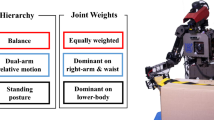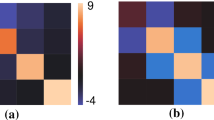Abstract
A general method is presented for the inverse kinematics resolution of redundant manipulators with joint limits. The success of avoiding joint angular position limits of the original clamping weighted least-norm method is ascribable to the strength of the repulsive potential field function. However, the repulsive potential field function may lead to excessive joint angular velocities that can exceed the corresponding limits. We propose an improved clamping weighted least-norm method that adds an elastic field function into the original method for the sake of sustaining the constraints of joint angular velocity limits. Moreover, for hierarchical task-level construction, the priority of avoiding joint angular velocity limits is lower than that of avoiding joint angular position limits. To adequately illustrate the effectiveness of the proposed method, case studies were performed in comparison with other methods in singular configurations of a redundant manipulator.
Similar content being viewed by others
References
J. Garrido, W. Yu and X. Li, Modular design and control of an upper limb exoskeleton, J. of Mechanical Science and Technology, 30 (5) (2016) 2265–2271.
L. S. Huang and R. K. Jiang, A new method of inverse kinematics solution for industrial 7DOF robot, Proc. of 32nd Chinese Control Conference, Xi’an, CHN (2013) 6063–6065.
H. Wang, Y. Jia, N. Xi and J. Buether, An online motion planning algorithm for a 7DOF redundant manipulator, Proc. of IEEE International Conference on Robotics and Biomimetics, Tianjin, CHN (2010) 1057–1062.
B. A. Liegeois, Automatic supervisory control of the configuration and behavior of multibody mechanisms, IEEE Transactions on Systems Man & Cybernetics, 7 (12) (1977) 868–871.
F. C. Tan and R. V. Dubey, A weighted least-norm solution based scheme for avoiding joint limits for redundant joint manipulators, IEEE Transactions on Robotics & Automation, 11 (2) (1995) 286–292.
M. Benzaoui, H. Chekireb and M. Tadjine, Redundant robot manipulator control with obstacle avoidance using extended jacobian method, Proc. of 18th Mediterranean Conference on Control & Automation, Marrakech, MAR (2010) 371–376.
M. Shimizu, H. Kakuya, W. K. Yoon, K. Kitagaki and K. Kosuge, Analytical inverse kinematic computation for 7-DOF redundant manipulators with joint limits and its application to redundancy resolution, IEEE Transactions on Robotics, 24 (5) (2008) 1131–1142.
R. C. Luo, T. W. Lin and Y. H. Tsai, Analytical inverse kinematic solution for modularized 7-DOF redundant manipulators with offsets at shoulder and wrist, Proc. of IEEE/RSJ International Conference on Intelligent Robots and Systems, Chicago, IL, USA (2014) 516–521.
J. K. Parker, A. R. Khoogar and D. E. Goldberg, Inverse kinematics of redundant robots using genetic algorithms, Proc. of IEEE International Conference on Robotics and Automation, Scottsdale, AZ, USA (1989) 271–276.
H. C. Huang, C. P. Chen and P. R. Wang, Particle swarm optimization for solving the inverse kinematics of 7-DOF robotic manipulators, Proc. of IEEE International Conference on Systems, Man, and Cybernetics, Seoul, KOR (2012) 3105–3110.
Z. W. Ren, Z. H. Wang and L. N. Sun, A hybrid biogeography-based optimization method for the inverse kinematics problem of an 8-DOF redundant humanoid manipulator, Frontiers of Information Technology & Electronic Engineering, 16 (7) (2015) 607–616.
J. Xiang, C. Zhong and W. Wei, A varied weights method for the kinematic control of redundant manipulators with multiple constraints, IEEE Transactions on Robotics, 28 (2) (2012) 330–340.
F. Flacco, A. D. Luca and O. Khatib, Control of redundant robots under hard joint constraints: saturation in the null space, IEEE Transactions on Robotics, 31 (3) (2015) 637–654.
O. Kanoun, F. Lamiraux and P. B. Wieber, Kinematic control of redundant manipulators: generalizing the task-priority framework to inequality task, IEEE Transactions on Robotics, 27 (4) (2011) 785–792.
S. Huang, J. Xiang, W. Wei and M. Z. Q. Chen, On the virtual joints for kinematic control of redundant manipulators with multiple constraints, IEEE Transactions on Control Systems Technology, PP (99) (2017) 1–12.
N. Mansard, O. Khatib and A. Kheddar, A unified approach to integrate unilateral constraints in the stack of tasks, IEEE Transactions on Robotics, 25 (3) (2009) 670–685.
S. Huang, Y. Peng, W. Wei and J. Xiang, Clamping weighted least-norm method for the manipulator kinematic control with constraints, International J. of Control, 89 (11) (2016) 2240–2249.
J. Xiang, C. Zhong and W. Wei, General-weighted leastnorm control for redundant manipulators, IEEE Transactions on Robotics, 26 (4) (2010) 660–669.
R. Roberts and E. Rodriguez-Leal, Kinematics and workspace-based dimensional optimization of a novel haptic device for assisted navigation, Mechanics Based Design of Structures and Machines, 44 (1–2) (2016) 43–57.
Y. Nakamura and H. Hanafusa, Inverse kinematic solutions with singularity robustness for robot manipulator control, Journal of Dynamic Systems, Measurement and Control, 108 (3) (1986) 163–171.
S. Chiaverini, B. Siciliano and O. Egeland, Review of the damped least-squares inverse kinematics with experiments on a industrial robot manipulator, IEEE Transactions on Control Systems Technology, 2 (2) (1994) 123–134.
D. Raunhardt and R. Boulic, Progressive clamping, Proc. of IEEE International Conference on Robotics and Automation, Roma, ITA (2007) 4414–4419.
P. Baerlocher and R. Boulic, An inverse kinematics architecture enforcing an arbitrary number of strict priority levels, The Visual Computer, 20 (6) (2004) 402–417.
M. P. Le, P. Martinet, S. Lee and H. Kim, Damped least square based genetic algorithm with Ggaussian distribution of damping factor for singularity-robust inverse kinematics, J. of Mechanical Science and Technology, 22 (7) (2008) 1330–1338.
G. Antonelli, Stability analysis for prioritized closed-loop inverse kinematic algorithms for redundant robotic systems, IEEE Transactions on Robotics, 25 (5) (2009) 985–994.
N. Y. Ko, J. S. Dong and R. G. Simmons, Collision-free motion coordination of heterogeneous robots, J. of Mechanical Science and Technology, 22 (11) (2008) 2090–2098.
J. A. Euler, R. V. Dubey and S. M. Babcock, Self motion determination based on actuator velocity bounds for redundant manipulators, J. of Robotics Systems, 6 (4) (1989) 417–425.
S. Lu, J. Zhao and L. Jiang, Gradient projection method of kinematically redundant manipulator based on improved scale factor, Proc. of 11th World Congress on Intelligent Control and Automation, Shenyang, CHN (2015) 4955–4960.
R. V. Dubey, S. McGhee and T. F. Chan, Probability-based weighting of performance criteria for redundant manipulators, J. of Intelligent and Robotic Systems, 19 (1) (1997) 89–103.
S. Baglioni, F. Cianetti, C. Braccesi and D. M. D. Micheli, Multibody modelling of N DOF robot arm assigned to milling manufacturing. Dynamic analysis and position errors evaluation, J. of Mechanical Science and Technology, 30 (1) (2016) 1–16.
Author information
Authors and Affiliations
Corresponding author
Additional information
Recommended by Associate Editor Baek-Kyu Cho
Jun Wan received the B.S. in Mechanical Engineering and Automation from Anhui University of Technology, China, in 2012 and the M.S. in Mechanical and Electrical Engineering from Anhui University of Technology, China, in 2015. He is currently a Ph.D. candidate in Mechanical and Electrical Engineering with Nanjing University of Aeronautics and Astronautics, China. His research interests include redundant robotics, nonlinear adaptive and robust control with applications to robotic systems and mechatronics.
HongTao Wu received the Ph.D. in Mechanical Engineering from Tianjin University, China, in 1992. He is currently a Professor with The College of Mechanical and Electrical Engineering, Nanjing University of Aeronautics and Astronautics. His research interests include multibody dynamics, parallel robotics and industrial automation and micro electro mechanical system.
Rui Ma received the M.S. in Solid Mechanics from Jiangsu University, China, in 2014. He is currently a Ph.D. candidate in Mechanical and Electrical Engineering with Nanjing University of Aeronautics and Astronautics, China. His research interests include visonbased control, autonomous flight control and artificial intelligence with applications to unmanned aerial vehicles.
Liang’an Zhang received the B.S. in Mechanical Engineering and Automation from Harbin Institute of Technology, China, in 2004 and the M.S. and Ph.D. both in Mechanical Engineering and Automation from Tianjin University, China, in 2007 and 2010, respectively. He is an Associate Professor with the Mechanical Engineering Department at Anhui University of Technology, China, since 2012. He is the Chief Executive of Anhui Hiseed Robot Company Limited, China. His research interests include modeling and nonlinear control of robotics, mechatronic integration and applications to robotic systems.
Rights and permissions
About this article
Cite this article
Wan, J., Wu, H., Ma, R. et al. A study on avoiding joint limits for inverse kinematics of redundant manipulators using improved clamping weighted least-norm method. J Mech Sci Technol 32, 1367–1378 (2018). https://doi.org/10.1007/s12206-018-0240-7
Received:
Revised:
Accepted:
Published:
Issue Date:
DOI: https://doi.org/10.1007/s12206-018-0240-7




